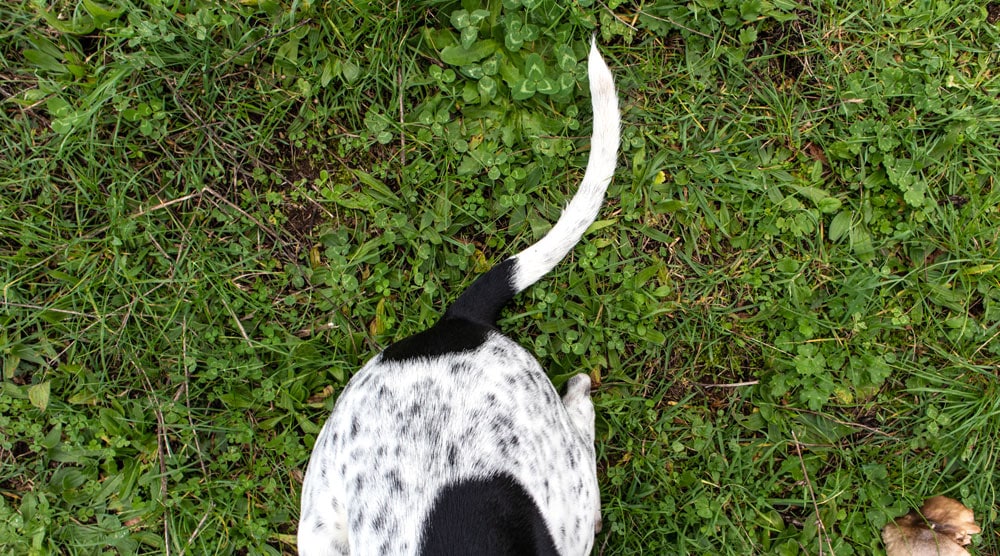It can be scary if your dog’s tail stops wagging, hangs limply, or develops a bend or kink. These symptoms could mean that the tail is fractured or dislocated. However, they could also be caused by other medical conditions, such as limber tail syndrome, nerve damage, or muscle strains.
In this article, we’ll discuss how to identify a broken tail and how to differentiate between various types of tail problems. We’ll also talk about how to treat a broken tail and how to avoid fractures from happening in the first place.
Contents
Understand Your Dog’s Tail Anatomy
Dogs use their tails for much more than just a happy wag. For example, tails are vital for maintaining balance and allowing for communication with other dogs – and us humans, too!
So, what exactly is a dog’s tail made of? It might look soft and fluid, but the tail is essentially an extension of the spine. And, like the rest of the spine, it is comprised of vertebral bones.
There can be up to 23 vertebral bones in some breeds, although dogs with short tails may have as little as 5-6. The bones are larger at the base of the tail, getting progressively smaller towards the end.
The tail also consists of skin, nerves, muscles, cartilage, and connective tissues. The muscles attach to the bones, giving the dog the ability to move its tail, while the nerves control these movements. The cartilage provides cushioning, ensuring the vertebrae don’t rub together.
Because it is always active and exposed, the tail is prone to injury. While any tail can suffer from a fracture, dislocation, or other medical issues, these injuries are more common in dogs with longer tails.
Common Causes of Broken or Dislocated Tails
Now that we understand the anatomy of a dog’s tail, let’s delve into the difference between a tail break and a dislocation.
A dislocation is when two of the tail vertebrae become separated. This is different from a break, which is when one (or more) of the vertebrae contain a fracture.
Despite the differences, similar incidents can cause both types of injuries. Common culprits include:
- Tail getting caught in a door
- Tail accidentally being stepped on
- Tail being pulled (avulsion)
- Dog being struck by a moving object (like a car)
- Dog falling onto the tail
The severity of a break often depends on its location. Breaks or dislocations near the base of the tail are less likely to heal naturally than those towards the tip. Some tail breaks may also involve fractures to multiple tail vertebrae.
Keep in mind that a tail injury can be extremely painful for a dog. If you suspect a tail problem, don’t hesitate – seek veterinary care immediately, no matter where the suspected break is. Remember, it’s always better to be safe than sorry when it comes to your dog’s health and comfort.
Warning Signs Your Dog Has a Broken Tail
There are many potential symptoms of a broken dog tail. These range from swelling to changes in behaviour.
However, a variety of tail issues can cause similar symptoms. While the warning signs listed below might indicate a break, they could also be associated with other medical problems, such as a sprain or nerve damage. So, an accurate diagnosis is key.
- Behavioral changes: Like humans, dogs exhibit changes in behavior when they’re feeling ill or in pain. A dog with a tail injury might appear less active, constantly lick their tail, or engage in tail tucking.
- Changes in tail positioning: Every breed has its “neutral” tail position. A broken tail may cause a deviation from this, such as the tail drooping or being held in an unusual position. A dog in pain may also keep their tail tucked.
- Swelling: Swelling and redness around the injured area are common signs of a broken bone, and the tail is no different.
- Difficulty walking: Tail injuries can cause pain that affects your dog’s normal gait. They may struggle to walk or run as they usually do.
- Changes in wagging: A usually vibrant wag may appear limp or lethargic if your dog’s tail is broken. They may even struggle to wag it at all.
- Vocalizations: Injuries like dislocations can be very painful for dogs. If your pet is whimpering or crying, this is most likely a sign of distress.
- Kinks or bumps in the tail: Kinks or bumps in the tail may indicate a break, although other medical issues can also cause them.
- Guarding the tail: Dogs often guard parts of their bodies that are causing them discomfort. Even after the bone has healed, the dog may not like the previous injury location to be touched.
Additionally, a break near the tail base can damage nerves that are essential for controlling bowel movements. If this happens, it could lead to incontinence or other bowel problems.

Could Your Dog Have Limber Tail Syndrome Instead?
A condition known as limber tail syndrome (acute caudal myopathy) can cause similar symptoms to a tail break. These include a limply hanging tail and behaviour change.
This condition is often caused by the tail being overused. It’s especially common in dogs who’ve been swimming in cold water – hence the alternate name, “cold water” tail. If the issue is indeed overuse, a good rest might often solve the problem. However, be aware that symptoms could also be triggered by conditions such as infections, neurological damage, and anal gland issues, all of which require veterinary treatment.
So, it’s crucial to get your pet to a vet if you suspect a problem. They can provide an accurate diagnosis and ensure your dog gets the right treatment.
Broken Tail Treatment
If you suspect your dog has a broken or dislocated tail, it’s essential to take them to a vet as soon as possible – even if the fracture doesn’t seem severe. Never underestimate the potential pain and discomfort a tail injury can cause to your furry friend.
During your vet visit, an X-ray of the tail is typically necessary. Scans are often the only definitive way to tell whether the tail is fractured or strained.
For minor breaks, the vet might determine that the fracture will naturally heal and doesn’t require intervention other than pain relief (although a bump might permanently remain at the fracture location). In some cases, the vet may also attempt to reset the tail if the break happened very recently.
When a tail cannot be reset, managing pain and preventing further injury become the focus of treatment. Since it’s impossible to put a tail in a cast, rest, pain management, and tail protection are often the primary approaches. In cases of severe damage, amputation may sadly be the only option.
Can a Broken Tail Heal On Its Own?
The potential for a broken tail to heal independently depends on the severity and location of the fracture.
Minor fractures may mend over time without treatment, while severely fractured or crushed vertebrae will almost certainly need veterinary treatment.
The location of the fracture also influences the healing process. Fractures at the tail tip are more likely to heal naturally, though there might still be a residual kink or bump. Conversely, fractures at the tail base often require medical intervention, as the bones are larger, and nerve damage is more likely.
How Long Does a Broken Dog Tail Take to Heal?
Predicting a timeline for tail healing can be challenging, as every fracture or dislocation is unique.
A minor hairline fracture might heal naturally within a few weeks. However, a severe fracture with accompanying nerve damage may take several months to heal and could need surgery for optimal recovery. As always, prompt and appropriate veterinary care is the best course of action.
Other Tail Injury Symptoms And How to Treat Them
It’s important to remember that there are many other potential tail injuries or medical issues besides a broken tail. Each of these problems requires different treatments, which is why it’s crucial to seek veterinary advice when your dog shows signs of tail distress.
Tail Wounds (Lacerations, Abrasions)
Tails often get wounded, whether through snagging on thorns, getting caught on a wire fence, being bitten by another dog, or even self-inflicted by the dog biting its own tail. That last scenario could point to another medical or behavioural problem that needs addressing.
Abrasions are wounds affecting the superficial skin layers of the tail. Minor abrasions often don’t require veterinary treatment, as they can be managed at home.
For a minor abrasion, clean the wound with warm water and mild soap, then apply a dog-safe antibiotic ointment before bandaging the area with self-adhering wrap. This barrier prevents your dog from licking and irritating the wound. Ensure the bandage doesn’t restrict blood flow and change it daily until healed.
Lacerations are deeper wounds that can reach down to the muscle or even bone. Deep lacerations, large abrasions, or wounds that won’t stop bleeding require emergency veterinary treatment. To control bleeding, use a towel and get your dog to the vet immediately. Stitches, protective bandages, and stronger antibiotics may be needed.
Happy Tail Syndrome
Happy tail is a condition where a dog repeatedly wags its tail against hard objects (like walls, floors, tables, or trees), leading to ulcer formation and bleeding.
Despite the misleadingly cheerful name, this is a serious condition. The ulcers often don’t heal because the wagging doesn’t pause long enough for recovery, and exposed nerve endings can cause intense pain.
If your dog exhibits signs of happy tail syndrome or you notice wounds on their tail, consult a vet. Antibiotics, pain killers, and bandages can sometimes promote healing. An Elizabethan collar might prevent the dog from licking the wound. However, in severe cases, partial amputation of the tail may be necessary.
Happy Tail In Dog Rescue Centers: A Trainer’s Perspective
“Working in a rescue centre, happy tail was sadly a frequent issue, due to the narrowness of the kennels and the overwhelming environment. It was especially common in lurchers and greyhounds, as they have long, delicate tails without much fur for padding.”
“The dogs were always so stoic about their injuries, so the first sign was usually smatterings of blood on the kennel walls. Where possible, we would always try and move the dogs into a bigger kennel, but if we were at maximum capacity this wasn’t always possible. The onsite vet team would try and bandage and pad out the end of their tails, which sometimes helped – but not always, as they could easily wag it off again!”
“We would also try and add as many blankets and soft furnishings into their kennel, so that if they did hit their tail it wasn’t quite as bad.”
“Then there was management of our own behaviour. We would try not to get them overexcited when we entered the kennel to prevent more tail wagging. This usually worked if we also scattered treats on the floor.”
– Rebecca Morello IMDT
Limber Tail (Also Called Limp Tail, Cold Tail or Swimmer’s Tail)
Limber tail, or acute caudal myopathy, is a condition thought to arise from overuse or strain of the tail muscles.
It’s commonly seen in dogs after a long swim or extended physical activity, or in dogs confined in a crate for prolonged periods. This condition is most prevalent in working breeds, like Labrador Retrievers and Foxhounds, but it can affect any dog.
The primary symptom is a painfully limp tail. In some cases, the entire tail becomes limp, while in others, only the tip shows limpness. The dog may also chew at the tail base or have difficulty standing.
These symptoms mimic those of a broken tail, underlining the importance of veterinary assessment. Rest and anti-inflammatory medication typically suffice for treating limber tail.
Strains and Sprains
The muscles and ligaments in a tail are essential for the dog’s fine motor control. When these muscles or ligaments are strained or sprained, the dog may struggle to hold the tail in a normal position or wag it. This symptom is often accompanied by pain and discomfort.
Such strains and sprains can be brought about by overuse or by a specific injury. While minor strains and sprains tend to naturally heal within several days, it’s advisable to contact a vet for treatment if the dog’s tail shows no signs of improvement after 2-3 days.
Allergies, Infections, and Skin Irritation
The skin enveloping a dog’s tail is susceptible to the same conditions as skin anywhere else on the body. This means it can be affected by issues like fleas, allergies, and hot spots.
If you observe your dog incessantly licking its tail, or if there are red patches or fur loss on the tail, it’s important to consult a vet for advice.
Nerve Damage
Tail nerves are linked to the bladder and bowels. So, damage to these nerves can impact tail movements and cause incontinence issues.
In some instances, tail nerves are damaged by direct trauma, such as the tail being slammed in a door. In others, a shifted tail vertebra might exert pressure on the nerve, causing pinching.
However, the most common cause of nerve damage is avulsion, which occurs when the tail is pulled by something. This can stretch or even break the nerves.
Nerve damage must always be diagnosed and treated by a vet. If the nerve damage arises from a disc issue, treating that may alleviate other symptoms. If not, the symptoms can often be managed using medications like steroids or pain relief drugs.
Over time, nerve damage may heal, but your dog may need treatment during this recovery process.
When Should You Contact Your Vet About a Tail Injury?
Home treatment is often sufficient for minor cuts and scrapes on a dog’s tail. However, any other tail-related issues should ideally be diagnosed and treated by a vet.
Emergency medical treatment should be sought if your dog displays any of the following symptoms:
- Intense pain as evidenced by vocalizations, pacing, or other signs
- Bleeding that can’t be stopped
- A noticeable bump or kink in the tail
- Symptoms such as vomiting, diarrhea, or difficulty walking
If you notice other symptoms like a limp tail, a change in gait, tail guarding, behaviour change, skin problems or hot spots, or difficulty wagging the tail, book a vet appointment as soon as possible.
In situations when your dog has been involved in an accident, it’s important to visit a vet immediately. Dogs instinctively hide pain and illness, so a thorough check-up is crucial, even if there aren’t any outward signs of injury.
Tips for Preventing Tail Injuries
Dog tail injuries are often caused by accidents. While they can’t be completely prevented, here are some tips for minimising the change of an injury:
- Always check where your dog is before shutting a door. Door slams are among the most common causes of tail breaks or dislocations.
- Keep your dog away when you’re engaged in a task requiring concentration. Consider confining your pet to a different room when you’re cooking, for instance.
- Be careful when examining your dog’s tail or rear-end. If you need to move the tail, always move it to the side rather than lifting it up.
- Exercise caution when closing car doors if your dog is nearby. It’s common for dogs’ tails to hang out the door after they leap into the car. Dogs may also suddenly jump into the car, posing a serious risk if you’re shutting the door.
- Avoid encouraging your dog to jump from high places. The tail can easily get caught during the descent.
- Ensure all child-dog interactions are supervised and teach your children never to touch a dog’s tail. Children may not understand the potential harm that can be inflicted by pulling the tail.
- Always look behind before moving your office chair backwards. Dogs often like to sleep close to their owners, making it easy to forget their presence.
- Avoid over-exercising your dog. While this may not lead to a tail injury directly, it can result in muscle fatigue and potentially, limber tail syndrome.
Broken Dog Tail FAQs
How Serious is a Broken Tail?
The severity of a broken tail can vary depending on the extent of the fracture and the location of the injury. All broken tails are very painful though, so even minor breaks need veterinary care.
Minor tail fractures can often heal over a period of several weeks. These injuries might not require any treatment beyond pain relief medication and safeguarding the tail from further harm.
Severe fractures, on the other hand, may impact the nerves, leading to issues like incontinence and affecting your dog’s quality of life. In some cases, a tail amputation might be necessary.
How Much Does It Cost To Treat a Broken Tail?
This is a legitimate concern for many pet owners. However, there are too many factors to provide a precise figure.
For minor breaks, you may only need to cover the cost of an X-ray to assess the severity of the fracture, in addition to pain relief medication. In contrast, if surgery (such as a tail amputation) is required, the costs could significantly increase.
Summary
In this guide, we’ve discussed dog tail anatomy, the causes of tail breaks, and how they are treated. We’ve also looked at other tail injuries and when to contact a vet.
If you notice any issues with your dog’s tail, then it’s important to take them to a vet as soon as possible. Tail injuries can be very painful, and are also often linked to nerve damage and other issues. So, it’s important not to take any chances with your pet’s health.
Do you have any questions about dog tail breaks or other injuries? Please let us know in the comments section below.




